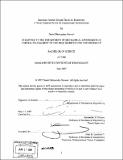| dc.contributor.advisor | Alexander H. Slocum. | en_US |
| dc.contributor.author | Hernandez-Stewart, Daniel | en_US |
| dc.contributor.other | Massachusetts Institute of Technology. Dept. of Mechanical Engineering. | en_US |
| dc.date.accessioned | 2008-02-27T22:25:05Z | |
| dc.date.available | 2008-02-27T22:25:05Z | |
| dc.date.copyright | 2007 | en_US |
| dc.date.issued | 2007 | en_US |
| dc.identifier.uri | http://hdl.handle.net/1721.1/40433 | |
| dc.description | Thesis (S.B.)--Massachusetts Institute of Technology, Dept. of Mechanical Engineering, 2007. | en_US |
| dc.description | Includes bibliographical references (leaves 17-18). | en_US |
| dc.description.abstract | The Endoblend device concept was developed by a 2.75 design team,of which I was a member; the purpose of the device is to remove tissue laparoscopically. The detailed design of one of its modules, the enclosure module, is the subject of this paper. The Endoblend has the potential to reduce morcellation surgery time from upwards of half an hour to minutes, with reduced risk of the most common complications of nicking the abdomen wall and leaving tissue behind. There are three primary functional requirements of the enclosure module. First, for ease of use, simplicity, and safety the bag and guard in combination must passively feed the tissue into the blades. This was accomplished using, a cone shape to make the bottom of the bag act as an equilibrium state through a gravity feed. Second, the bag must remain intact to prevent tissue from being left behind. To accomplish this it will be shaped with a flat region near the blades so that inflating the bag keeps it away from the blades, and the Ziploc type seal through which the tissue enters will be a double seal with micro beads of cyanocrolate to make a strong permanent seal. | en_US |
| dc.description.abstract | (cont.) Third, since the main benefit of the Endoblend is shorter surgery time, it is vital that the extra steps incurred from use of the enclosure module do not take up a significant portion of the time saved by its rapid tissue processing capabilities. The prototype bag met these functional requirements, and was used to successfully process tissue in a bench-top experiment. The successful design and integration of the enclosure module will allow this project to continue moving forward. This thesis along with the thesis on the guard answered the remaining critical questions that preceded putting together a next iteration prototype to use in order to perform animal tests. | en_US |
| dc.description.statementofresponsibility | by Daniel Hernandez-Stewart. | en_US |
| dc.format.extent | 18 leaves | en_US |
| dc.language.iso | eng | en_US |
| dc.publisher | Massachusetts Institute of Technology | en_US |
| dc.rights | M.I.T. theses are protected by copyright. They may be viewed from this source for any purpose, but reproduction or distribution in any format is prohibited without written permission. See provided URL for inquiries about permission. | en_US |
| dc.rights.uri | http://dspace.mit.edu/handle/1721.1/7582 | |
| dc.subject | Mechanical Engineering. | en_US |
| dc.title | Enclosure module design thesis for Endoblend : a novel surgical device for laparoscopic hysterectomy | en_US |
| dc.type | Thesis | en_US |
| dc.description.degree | S.B. | en_US |
| dc.contributor.department | Massachusetts Institute of Technology. Department of Mechanical Engineering | |
| dc.identifier.oclc | 191700689 | en_US |
